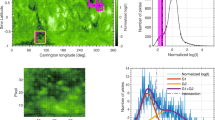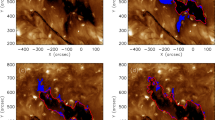Abstract
Coronal holes (CHs) are regions of open magnetic field lines in the solar corona and the source of the fast solar wind. Understanding the evolution of coronal holes is critical for solar magnetism as well as for accurate space weather forecasts. We study the extreme ultraviolet (EUV) synoptic maps at three wavelengths (195 Å/193 Å, 171 Å and 304 Å) measured by the Solar and Heliospheric Observatory/Extreme Ultraviolet Imaging Telescope (SOHO/EIT) and the Solar Dynamics Observatory/Atmospheric Imaging Assembly (SDO/AIA) instruments. The two datasets are first homogenized by scaling the SDO/AIA data to the SOHO/EIT level by means of histogram equalization. We then develop a novel automated method to identify CHs from these homogenized maps by determining the intensity threshold of CH regions separately for each synoptic map. This is done by identifying the best location and size of an image segment, which optimally contains portions of coronal holes and the surrounding quiet Sun allowing us to detect the momentary intensity threshold. Our method is thus able to adjust itself to the changing scale size of coronal holes and to temporally varying intensities. To make full use of the information in the three wavelengths we construct a composite CH distribution, which is more robust than distributions based on one wavelength. Using the composite CH dataset we discuss the temporal evolution of CHs during the Solar Cycles 23 and 24.













Similar content being viewed by others
Notes
After completing the analysis discussed in this article, it came to our knowledge that the Space Weather Lab synoptic maps, whose pixel values appeared to represent logarithmic pixel intensity in the numerical range from 0 to 255, correspond to 8-bit color table pixel values of the map used to plot the images (Karna, 2017, private communication). The erroneous synoptic maps have been in the public server for several years, and they have been used in a few publications, but have recently (November 2017) been corrected. Fortunately, the map used was monochromatic so that the color table values are proportional to the real pixel intensity. Thus, this is not a problem for the novel CH detection method presented in this article, which relies on contrasts between pixel values. However, a more significant problem might occur that can be related to the fact that the color table values clip the real pixel values below (above) the lower (upper) threshold. This clipping of pixel values is clearly seen in the SDO/AIA histograms of Figure 1.
References
Abramenko, V., Yurchyshyn, V., Watanabe, H.: 2009, Parameters of the magnetic flux inside coronal holes. Solar Phys. 260(1), 43. DOI .
Asikainen, T., Ruopsa, M.: 2016, Solar wind drivers of energetic electron precipitation. J. Geophys. Res. 121(3), 2209. DOI .
Barra, V., Delouille, V., Kretzschmar, M., Hochedez, J.-F.: 2009, Fast and robust segmentation of solar EUV images: Algorithm and results for solar cycle 23. Astron. Astrophys. 505(1), 361. DOI .
Belkasim, S., Ghazal, A., Basir, O.A.: 2003, Phase-based optimal image thresholding. Digit. Signal Process. 13(4), 636. DOI .
Benevolenskaya, E.E., Kosovichev, A.G., Scherrer, P.H.: 2001, Detection of high-latitude waves of solar coronal activity in extreme-ultraviolet data from the solar and heliospheric observatory EUV imaging telescope. Astrophys. J. 554, L107. DOI .
Boerner, P.F., Testa, P., Warren, H., Weber, M.A., Schrijver, C.J.: 2014, Photometric and thermal cross-calibration of solar EUV instruments. Solar Phys. 289(6), 2377. DOI .
Caplan, R.M., Downs, C., Linker, J.A.: 2016, Synchronic coronal hole mapping using multi-instrument EUV images: Data preparation and detection method. Astrophys. J. 823(1), 53. DOI .
Cranmer, S.R.: 2009, Coronal holes. Living Rev. Solar Phys. 6(3), 14. DOI .
de Toma, G.: 2011, Evolution of coronal holes and implications for high-speed solar wind during the minimum between cycles 23 and 24. Solar Phys. 274(1), 195. DOI .
de Toma, G., Arge, C.N.: 2005, Multi-wavelength observations of coronal holes. ASP Conf. Ser. 346, 251.
Delaboudinière, J.-P., Artzner, G.E., Brunaud, J., Gabriel, A.H., Hochedez, J.F., Millier, F., Song, X.Y., Au, B., Dere, K.P., Howard, R.A., Kreplin, R., Michels, D.J., Moses, J.D., Defise, J.M., Jamar, C., Rochus, P., Chauvineau, J.P., Marioge, J.P., Catura, R.C., Lemen, J.R., Shing, L., Stern, R.A., Gurman, J.B., Neupert, W.M., Maucherat, A., Clette, F., Cugnon, P., Van Dessel, E.L.: 1995, EIT: Extreme-ultraviolet imaging telescope for the SOHO mission. Solar Phys. 162, 291. DOI .
Floyd, L., Rottman, G., Deland, M., Pap, J.: 2003, 11 years of solar UV irradiance measurements from UARS. In: Wilson, A. (ed.) Solar Variability as an Input to the Earth’s Environment, ESA SP-535, 195.
Floyd, L., Newmark, J., Cook, J., Herring, L., McMullin, D.: 2005, Solar EUV and UV spectral irradiances and solar indices. J. Atmos. Solar-Terr. Phys. 67(1), 3. DOI .
Gallagher, P.T., Phillips, K.J.H., Harra-Murnion, L.K., Keenan, F.P.: 1998, Properties of the quiet Sun EUV network. Astron. Astrophys. 335, 733.
Gallagher, P.T., Mathioudakis, M., Keenan, F.P., Phillips, K.J.H., Tsinganos, K.: 1999, The radial and angular variation of the electron density in the solar corona. Astrophys. J. 524(2), L133. DOI .
Gonzalez, R., Woods, R.: 2002, Dig. Image Proc. 190, 0201180758. DOI .
Gosling, J.T., Pizzo, V.J.: 1999, Formation and evolution of corotating interaction regions and their three dimensional structure. Space Sci. Rev. 89(1), 21. DOI .
Harvey, K.L., Recely, F.: 2002, Polar coronal holes during cycles 22 and 23. Solar Phys. 211, 31. DOI .
Harvey, J.W., Sheeley, N.R.: 1979, Coronal holes and solar magnetic fields. Space Sci. Rev. 23, 139. DOI .
Hathaway, D.H., Upton, L.: 2014, The solar meridional circulation and sunspot cycle variability. J. Geophys. Res. 119(5), 3316. DOI .
Henney, C.J., Harvey, J.W.: 2007, Automated coronal hole detection using He I 1083 nm spectroheliograms and photospheric magnetograms. ASP Conf. Ser. 346, 261.
Hess Webber, S.A., Karna, N., Pesnell, W.D., Kirk, M.S.: 2014, Areas of polar coronal holes from 1996 through 2010. Solar Phys. 289, 4047. DOI .
Holappa, L., Mursula, K., Asikainen, T., Richardson, I.G.: 2014, Annual fractions of high-speed streams from principal component analysis of local geomagnetic activity. J. Geophys. Res. 119(6), 4544. DOI .
Kahler, S.W., Davis, J.M., Harvey, J.W.: 1983, Comparison of coronal holes observed in soft X-ray and He 10830 Å spectroheliograms. Solar Phys. 87, 47. DOI .
Kahler, S.W., Hudson, H.S.: 2002, Boundary structures and changes in long-lived coronal holes. Astrophys. J. 574(1), 467. DOI .
Karna, N., Hess Webber, S.A., Pesnell, W.D.: 2014, Using polar coronal hole area measurements to determine the solar polar magnetic field reversal in solar cycle 24. Solar Phys. 289(9), 3381. DOI .
Kirk, M.S., Pesnell, W.D., Young, C.A., Hess Webber, S.A.: 2009, Automated detection of EUV polar coronal holes during solar cycle 23. Solar Phys. 257, 99. DOI .
Krieger, A.S., Timothy, A.F., Roelof, E.C.: 1973, A coronal hole and its identification as the source of a high velocity solar wind stream. Solar Phys. 29, 505. DOI .
Krista, L.D., Gallagher, P.T.: 2009, Automated coronal hole detection using local intensity thresholding techniques. Solar Phys. 256(1), 87. DOI .
Lowder, C., Jiong, Q., Leamon, R.: 2017, Coronal holes and open magnetic flux over cycles 23 and 24. Solar Phys. 292(1), 18. DOI .
Lukianova, R., Mursula, K.: 2011, Changed relation between sunspot numbers, solar UV/EUV radiation and TSI during the declining phase of solar cycle 23. J. Atmos. Solar-Terr. Phys. 73(2), 235. DOI .
McIntosh, S.W., Wang, X., Leamon, R.J., Howe, R., Krista, L.D., Malanushenko, A.V., Cirtain, J.W., Gurman, J.B., Thompson, M.J., Gurman, J.B., Pesnell, W.D., Thompson, M.J.: 2014, Deciphering solar magnetic activity I: On the relationship between the sunspot cycle and the evolution of small magnetic features. Astrophys. J. Lett. 792, L19. DOI .
McIntosh, S.W., Leamon, R.J., Krista, L.D., Title, A.M., Hudson, H.S., Riley, P., Harder, J.W., Kopp, G., Snow, M., Woods, T.N., Kasper, J.C., Stevens, M.L., Ulrich, R.K.: 2015, The solar magnetic activity band interaction and instabilities that shape quasi-periodic variability. Nat. Commun. 6, 6491. DOI .
Miralles, M.P., Cranmer, S.R., Panasyuk, A.V., Uzzo, M.: 2010, The tale of two minima and a solar cycle in between: An ongoing fast solar wind investigation. Astrophys. J. 428, 1.
Moses, D., Clette, F., Delaboudinière, J.-P., Artzner, G.E., Bougnet, M., Brunaud, J., Carabetian, C., Gabriel, A.H., Hochedez, J.-F., Millier, F., Song, X.Y., Au, B., Dere, K.P., Howard, R.A., Kreplin, R., Michels, D.J., Defise, J.-M., Jamar, C., Rochus, P., Chauvineau, J.P., Marioge, J.P., Catura, R.C., Lemen, J.R., Shing, L., Stern, R.A., Gurman, J.B., Neupert, W.M., Newmark, J.S., Thompson, B., Maucherat, A., Portier-Fozzani, F., Berghmans, D., Cugnon, P., Van Dessel, E.L., Gabryl, J.R.: 1997, EIT observations of the extreme ultraviolet Sun. Solar Phys. 175, 571. DOI .
Mursula, K., Holappa, L., Lukianova, R.: 2017, Seasonal solar wind speeds for the last 100 years: Unique coronal hole structures during the peak and demise of the grand modern maximum. Geophys. Res. Lett. 44(1), 30. DOI .
Mursula, K., Lukianova, R., Holappa, L.: 2015, Occurrence of high-speed solar wind streams over the grand modern maximum. Astrophys. J. 801(1), 30. DOI .
Neupert, W.M., Pizzo, V.: 1974, Solar coronal holes as sources of recurrent geomagnetic disturbances. J. Geophys. Res. 79, 3701. DOI .
Petkaki, P., Del Zanna, G., Mason, H.E., Bradshaw, S.J.: 2012, SDO AIA and EVE observations and modelling of solar flare loops. Astron. Astrophys. 547, A25. DOI .
Scholl, I.F., Habbal, S.R.: 2008, Automatic detection and classification of coronal holes and filaments based on EUV and magnetogram observations of the solar disk. Solar Phys. 248(2), 425. DOI .
Sheeley, N.R., Wang, Y.-M., Harvey, J.W.: 1989, The effect of newly erupting flux on the polar coronal holes. Solar Phys. 119, 323. DOI .
Sun, X., Todd Hoeksema, J., Liu, Y., Zhao, J.: 2015, On polar magnetic field reversal and surface flux transport during solar cycle 24. Astrophys. J. 798(2), 114. DOI .
Tousey, R., Sandlin, G.D., Purcell, J.D.: 1968, On some aspects of XUV spectroheliograms. In: Kiepenheuer, K.O. (ed.) Structure and Development of Solar Active Regions, IAU Symp. 35, 411. DOI .
Tsurutani, B.T., Gonzalez, W.D., Gonzalez, A.L.C., Tang, F., Arballo, J.K., Okada, M.: 1995, Interplanetary origin of geomagnetic activity in the declining phase of the solar cycle. J. Geophys. Res. 100, 21717. DOI .
Vernova, E.S., Mursula, K., Tyasto, M.I., Baranov, D.G.: 2002, A new pattern for the North–South asymmetry of sunspots. Solar Phys. 205(2), 371. DOI .
Virtanen, I., Mursula, K.: 2016, Photospheric and coronal magnetic fields in six magnetographs I. Consistent evolution of the bashful ballerina. Astron. Astrophys. 16(28096), 1. DOI .
Waldmeier, M.: 1957, Die sonnenkorona II, Birkhäuser, Basel. DOI .
Wang, Y.-M.: 2004, The Sun’s large-scale magnetic field and its long-term evolution. Solar Phys. 224(1), 21. DOI .
Wang, Y.-M., Sheeley, N.R.: 2002, Sunspot activity and the long-term variation of the Sun’s open magnetic flux. J. Geophys. Res. 107(A10), 1302. DOI .
Zirker, J.B. (ed.): 1977, Coronal Holes and High Speed Wind Streams, Colorado Assoc. Univ. Press, Boulder. DOI .
Acknowledgements
We acknowledge the financial support by the Academy of Finland to the ReSoLVE Centre of Excellence (projects 272157, 307411) as well as to project 257403. The EUV/magnetogram synoptic map data were obtained from the Stanford Solar Observatories Group ( http://sun.stanford.edu/synop/EIT/index.html ) and the Space Weather Lab at George Mason University (http://space_weather.gmu.edu/projects/ synop). The monthly sunspot areas were obtained from the Royal Observatory of Greenwich – USAF/NOAA Sunspot Data center ( https://solarscience.msfc.nasa.gov/greenwch.shtml ).
Author information
Authors and Affiliations
Corresponding authors
Ethics declarations
Disclosure of Potential Conflicts of Interest
The authors declare that they have no conflicts of interest.
Rights and permissions
About this article
Cite this article
Hamada, A., Asikainen, T., Virtanen, I. et al. Automated Identification of Coronal Holes from Synoptic EUV Maps. Sol Phys 293, 71 (2018). https://doi.org/10.1007/s11207-018-1289-2
Received:
Accepted:
Published:
DOI: https://doi.org/10.1007/s11207-018-1289-2




